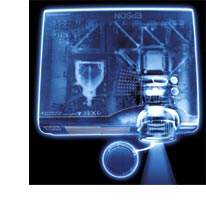Epsonow Magazine
Page 36 - Behind the light

Epson is a major force in the Australian multimedia projector market. Underpinning this is Epson's commitment to implementation, research and development of new projector technologies.
Polarisation Conversion Technology
Polarisation Conversion is a technology for achieving high optical efficiency and super brightness. This technology has been used on the Epson EMP range since the launch of the EMP-3500 in December 1996. Prior to the use of Polarisation Conversion, projectors could only utilise half of the total light volume due to the particular characteristics of the LCD (Liquid Crystal Display) polariser.
The polariser is required to enable the LCD to create polarised light, which passes through the LCD. However, polarised light shines in two directions with a 90 degree difference between the two directions. In previous optical systems, horizontal polarisation light was reflected back by the LCD polariser and therefore, wasted.
The Polarisation Conversion technology uses polarisation splitters to change the horizontal polarisation light to vertical polarisation light by a thin polarisation conversion prism, thereby increasing the amount of light through the LCD. As a result, the optical efficiency becomes 1.5 to 1.9 times better than in projectors that do not utilise the polarisation conversion system.
Panel On Prism (POP) Technology
Panel On Prism is a technology utilised to achieve a reduction in the physical size of projectors and provide stable optical characteristics. Utilising three LCDs rather than one, POP technology delivers higher image quality and brightness because it doesn't need a colour filter and therefore can focus red, green and blue lights to the same point. To achieve this, positioning of the three LCD's needs to be done with incredible precision during manufacture. In non-POP technology systems that use three LCDs, physical impact and even heat can cause a shift in the position of the LCD resulting in pixel misalignment and focus misadjustment.
To avoid this happening, POP technology incorporates a bonding of the three LCDs to the prism after undergoing incredibly fine optical adjustment. This means that the projector can suffer impact but the LCDs remain in the same finely tuned position.
Advanced Image real time Resizing (AIrR™) Technology
AIrR is an Epson original technology for achieving the best image quality in different resolutions displays.
AIrR for reducing resolution - In compression mode such as SXGA to XGA, AIrR circuitry samples by synchronised dot clock to input signal (135MHz max.). The benefit of this technology is that it avoids the somewhat crude results produced by the traditional method of line dropping. Reduced resolution images retain a higher level of integrity ensuring they can be comfortably viewed even at large distances.
AIrR for increasing resolution - In expansion mode such as video to XGA, VGA to XGA or SVGA to XGA, according to Epson original algorithm, AIrR circuitry estimates and calculates additional pixel data. When displayed, the increased resolution (expanded) image, has a much higher level of resolution fidelity than can be achieved using the traditional fixed ratio expansion method.
E@sy Technology
With the release of the EMP-8150, Epson introduced a number of new innovations, making it arguably the most versatile projector ever developed by the company. Among these innovations was Epson's unique E@syMP technology, which allows the projector to link to a network via a 10/100BaseT link. In a wireless LAN environment, E@syMP delivers true PC- and cable-free access to presentations. In taking this even one step further, the technology enables users to transmit presentations to the projector's built-in memory, giving total freedom even in the absence of any network connection during the presentation.
Complementing E@syMP is Epson's E@syView - With this firmware technology, native support is provided for commonly used file formats, which include Microsoft PowerPoint 97, Microsoft Word 97, Corel WordPerfect for Windows, Corel Presentations, JPEG, TIFF and numerous others.
The EMP-8150 also brought with it additional advanced input/output features by way of E@syBoard and E@syCapture, the former allowing a USB mouse, keyboard or graphics tablet to be used as an input device, connecting directly to the USB ports of the projector. With E@syCapture, the contents of this "electronic whiteboard" can be saved in JPEG file format to the projector's PCMCIA card or direct to a PC across the LAN.
